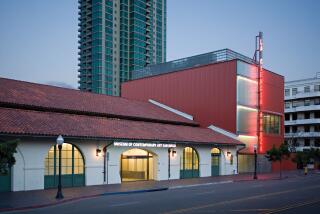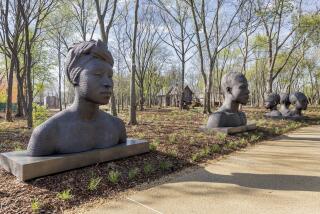At Cal State Long Beach, an art exhibition on police violence turns into protest over the firing of the museum’s director
The Sunday opening of artist lauren woods’ “American Monument” at the University Art Museum at Cal State Long Beach was meant to protest police violence against African Americans. But the event turned into a different sort of public protest, after the recent firing of the museum’s director, Kimberli Meyer.
The centerpiece of the exhibition is woods’ interactive sound installation featuring 25 record players, lined up in rows in a gallery, emitting audio ephemera from cases related to African Americans who have died as a result of altercations with police. The audio includes the last voicemail of Sandra Bland to a friend before she died in prison in 2015; sound from the police bodycam footage from the 2016 shooting of Alton Sterling; as well as Philando Castille’s girlfriend’s Facebook Live recording of his death. As visitors made their way through the exhibition, playing the recordings for themselves, the collective sound would commingle in the gallery.
But at the opening, it was silence that made the biggest impact.
During the event, woods (purposefully spelled lower case), welcomed guests and introduced her work before reading what would have been Meyer’s opening remarks. Then she played an excerpt of the Philando Castille Facebook Live recording before lifting the needle and bringing the audio to a halt. She then read her own statement, calling for Meyer’s reinstatement, and she switched off nearby turntables. Finally, four project “supporters” she’d enlisted filtered down the aisles, switching off all the remaining record players.
Silence enveloped the room. The artist then walked out, returning later to retrieve the acetate records.
“It was something I felt I had to do,” woods says. “I don’t want anyone to misconstrue that I’m putting myself at the center of the work, or Kimberli at the center, but without her leadership, I can’t do the work. The university could have made a different choice.”
The exhibition, which runs through Dec. 9, is still open, now under woods’ direction, the museum says. But the sound installation part of it, and the public programming related to the larger exhibition, is paused indefinitely.
They said they’d lost confidence in me and said they didn’t need to give me an explanation or tell me why.
— Kimberli Meyer
Meyer was fired on Sept. 11.
Meyer says that it was sudden and unexpected and that she hasn’t been given a proper explanation as to why. She was in her office on campus, she says, and the dean of the College of the Arts, Cyrus Parker-Jeannette, came in for what Meyer had thought would be a regular monthly meeting followed by someone from Human Resources. But they requested her badge, offered a severance check and escorted her out the door, as she recalls.
“They said they’d lost confidence in me and said they didn’t need to give me an explanation or tell me why,” Meyer says. “All I can say is that I’ve been fired and have been given no reason or cause, so I’ve filed an appeal. I’m shocked to have been so abruptly removed just days before the launch of ‘Monument,’ and I just don’t understand why.”
The university issued a statement on Monday. “While I cannot comment on personnel matters,” Parker-Jeannette wrote in the statement, “I can say this decision was part of a longer-term process. The ‘American Monument’ project continues at the museum as directed by the artist lauren woods. The installation is designed to provoke open and free discussion. Our campus is a place for civil discourse and artistic expression. ‘American Monument’ is part of this culture.”
In an email to the campus arts community on the day of the firing, Parker-Jeannette called Meyer “an asset to the museum and to the university” who has “helped expand the visibility of the museum in the community.”
Meyer came to University Art Museum at Cal State Long Beach from West Hollywood’s MAK Center for Art and Architecture in 2016 with the vision, she says, of making the museum’s program more social justice oriented. The contemporary art museum organizes about three to four exhibitions a year. Its spring exhibition this year, “Robert Irwin: Site Determined,” was a survey of more than four decades of the artist’s planning materials. Its Pacific Standard Time LA/LA exhibition, in 2017, “David Lamelas: A Life of Their Own,” was the first U.S. monographic exhibition of the Argentine-born artist.
Meyer had hoped to give the program a more political edge, she says.
“As director,” Meyer says, “my vision was to really try and take on the development of an anti-racist museum practice there — structural racism is everywhere, and cultural institutions have power, so how can that power be utilized to disrupt white supremacy? And this was my first big project there.”
The exhibition, which is “about language, law, violence and race,” as the university describes it, takes over all the museum’s exhibition space and examines the cultural circumstances under which police killings of African Americans take place. While organizing the exhibition over about a year, Meyer, woods and university students spent months compiling documents related to police violence acquired through the Freedom of Information Act. Enlarged versions of some of those documents, including an autopsy diagram and the 911 call chain from the shooting of Tamir Rice, are on view as an integral part of the exhibition.
“But we don’t think of it as an exhibition,” Meyer says. “It’s a monument, meant to transform the museum into a monument that helps people think about the cultural conditions under which African Americans lose their lives to police brutality. It was conceived as something that grows and moves beyond its first iteration, so it’s also process based, more work was to be done, more research.”
Meyer says the reason for her firing remains “the million dollar question.”
woods says that she felt “the choice to terminate her five days before the launch was an attempt to suffocate what the work was about.”
Terri Carbaugh, a spokesperson for the university, says those sentiments are entirely off the mark.
“It is important for people to understand that the departure of Kimberli Meyers is unrelated to the exhibit’s contents,” Carbaugh said by email. “We view our campus as an ideal place for important — and sometimes difficult — discussions to take place. While Ms. Meyers’ artistic vision is supported by the College of the Arts, the day-to-day and long-term operation of a university museum demands more.”
Meanwhile, woods wrote a letter that will remain on view in the museum for the duration of the period the installation is paused for.
“It’s paused. Not pulled. But paused,” she wrote. “It’s paused because I am calling for true partnership. I want to offer the university the chance to engage in a restorative process and demonstrate their commitment to the work of antiracism, an impulse that is evident by the choice to hire Kimberli Meyer, who declared upfront that this was the mission and vision for her tenure.”
Parker-Jeannette and College of the Arts administrative services manager Chanel Acker will oversee the museum as it searches for a new director.
Meyer’s appeal, filed with the university on Monday morning, is in process.
“I want to give them an opportunity to come back to the table and say, ‘Hey, we do want to support this kind of work,’ ” she says.
Follow me on Twitter: @debvankin
More to Read
The biggest entertainment stories
Get our big stories about Hollywood, film, television, music, arts, culture and more right in your inbox as soon as they publish.
You may occasionally receive promotional content from the Los Angeles Times.











